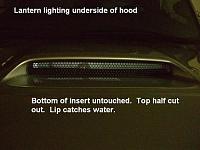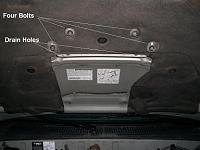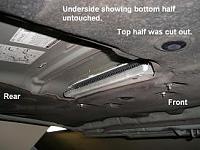Open Up Your Hood Scoop?
#1
Open Up Your Hood Scoop?
Has anybody thought of opening up the hood scoop on the 4Runner? I have tried it on two 4Runner sports. The hood scoop was designed initially for the Turbo diesel model sold in other parts of the world to cool the intercooler. It is on the Sport Edition for looks only. When opened it cools the Aluminium intake manifold which gets very hot due to the hot air from the radiator cooling fan. As you might know..hot air reduces the efficiency of the engine by hot air having a less charge of oxygen than cooler air. With the hood scoop opened the temp of the intake drops enough for you to hold it with your bare hands. Closed, it it is very hot and one cannot toutch it for more than a few seconds. Most modern engines have taken this into account and are making plastic intake manifolds which cut down intake temps.The 1GR-FE on the new Tacomas, 4Runners and FJ has a plastic intake manifold. I am sure opening the hood scoop to allow airflow over the manifold is a good idea even though i have not tested the effect in full detail. Water and rain entering the engine bay does not affect the engine at all....LETS KNOW WHAT YOU GUYS THINK.
Last edited by milowilli; 12-23-2006 at 12:09 PM.
#3
If only there was a search mechanism! Oh wait... there is!
https://www.yotatech.com/forums/f2/scoop-sr5-change-57547/
https://www.yotatech.com/forums/f2/scoop-sr5-change-57547/
#4
If only there was a search mechanism! Oh wait... there is!
https://www.yotatech.com/forums/showthread.php?t=57547
https://www.yotatech.com/forums/showthread.php?t=57547
 :bigclap:
:bigclap:
#6
How do you open up the hood scoop? After a search I found that some people have cut it out, others have said that it is a removable insert. I'd rather remove it without damaging the scoop or the insert. After looking at the underside of the hood, there are four bolts. Not sure if that secures the scoop to the hood or the insert to the scoop.
#7
Opened up the hood scoop tonight
Opened up the hood scoop tonight.
Tools needed:
10mm wrench
Sharpie pen
Dremmel tool or handheld rotational saw
1. Unbolt the four nuts on the underside of the hood. This unbolts the insert within the scoop.
2. Push the bolts straight up and you will see the insert move on the top of the hood. There is a single clip located in the middle of the two inner bolts. It is secured by a phillips screw. This clip secures the insert to the hood. I managed to break one side of the clip, (I didn't see the screw, and anyways the clip is not really necessary since there are four bolts securing the insert). Be careful if you would like to retain this clip, or unscrew it.
3. Continue to push directly up and maneuver the bolts to remove the insert from the top of the hood.
4. In order to minimize water seepage, I decided to cut out only the rear TOP HALF of the insert. This leaves a nice lip to catch water. Use a sharpie to draw the lines following the curve of the scoop before going at it with the saw. I believe some folks have cut out the entire rear, which allows water to drain down the scoop directly onto the intake manifold/supercharger. If the bottom of the insert is left untouched, it will act as a lip that will catch water and drain out the two small holes on the sides of the insert as it normally does stock. You could possibly run hoses to divert the water elsewhere so that it does not contact the intake manifold or supercharger.
Results:
The scoop is located over the supercharger, and not suprisingly the charger is louder outside of the truck when reving the engine. I don't necessarily believe that the convection alone is significant enough to create an increase in performance. However, the sound when in park reving past 3500 rpm is nice.
After going on an errand tonight and shutting the truck down, the scoop now vents a significant amount of heat. I don't know whether this translates to a faster cool down time. The underhood heat definitely escapes much better.
Tonight it was also raining. With the way I cut the rear of the scoop, there was only a small increase in water seepage.
Pics to come.
Tools needed:
10mm wrench
Sharpie pen
Dremmel tool or handheld rotational saw
1. Unbolt the four nuts on the underside of the hood. This unbolts the insert within the scoop.
2. Push the bolts straight up and you will see the insert move on the top of the hood. There is a single clip located in the middle of the two inner bolts. It is secured by a phillips screw. This clip secures the insert to the hood. I managed to break one side of the clip, (I didn't see the screw, and anyways the clip is not really necessary since there are four bolts securing the insert). Be careful if you would like to retain this clip, or unscrew it.
3. Continue to push directly up and maneuver the bolts to remove the insert from the top of the hood.
4. In order to minimize water seepage, I decided to cut out only the rear TOP HALF of the insert. This leaves a nice lip to catch water. Use a sharpie to draw the lines following the curve of the scoop before going at it with the saw. I believe some folks have cut out the entire rear, which allows water to drain down the scoop directly onto the intake manifold/supercharger. If the bottom of the insert is left untouched, it will act as a lip that will catch water and drain out the two small holes on the sides of the insert as it normally does stock. You could possibly run hoses to divert the water elsewhere so that it does not contact the intake manifold or supercharger.
Results:
The scoop is located over the supercharger, and not suprisingly the charger is louder outside of the truck when reving the engine. I don't necessarily believe that the convection alone is significant enough to create an increase in performance. However, the sound when in park reving past 3500 rpm is nice.
After going on an errand tonight and shutting the truck down, the scoop now vents a significant amount of heat. I don't know whether this translates to a faster cool down time. The underhood heat definitely escapes much better.
Tonight it was also raining. With the way I cut the rear of the scoop, there was only a small increase in water seepage.
Pics to come.
Trending Topics
#8
#11
If you went that far I'm not sure why you wouldn't just cut the entire back off the scoop insert? I mean water seepage isn't really an issue on the motor since you aren't linking the air intake to the scoop at all. The engine would get a heck of alot more water splashing around just going through a big puddle on the highway than you'd get driving rain through the scoop at highway speeds.
Good pics of what you did anyway.....there are also free pic hosting sites so you can make your pics alot bigger.
www.webshots.com
www.photobucket.com
www.imageshack.com
Good pics of what you did anyway.....there are also free pic hosting sites so you can make your pics alot bigger.
www.webshots.com
www.photobucket.com
www.imageshack.com
#12
I did not end up keeping the stock airbox. I went with a cheap $15 cone intake from ebay. Getting underhood temps down was/is somewhat of a goal for me.
Thanks for the free hosting links. I'll keep those in mind next time.
#13
i did it over a year ago. https://www.yotatech.com/forums/show...ght=hood+scoop
#14
Surf4runner, by any chance are you supercharged?
Yesterday I took the truck out to run errands, (city driving), and found the cone filter was warm and the intake pipe adjacent to the charger hot but bearable.
Today I took the truck out on the freeway and did some 3rd gear pulls. It felt like the truck was pulling harder than normal, and in my enjoyment, I ended up driving all the way to the end of the freeway in Kahala. After pulling into a side street, I opened the hood and was surprised to find that the intake cone was cool to the touch. Not warm, cool. The aluminum intake pipe at the junction of the cone filter was also cool. The pipe was only warm where it joins the supercharger. It was not hot whatsoever. Before modifying the scoop, on any drive, city or highway, the cone filter and the intake pipe would be hot to the touch. Adjacent the supercharger, unbearable.
These supercharged engines are apparently very temperature sensitive. In a recent post, I mentioned that when my truck's clutch fan comes on it actually adds power, (morning or after running errands doesn't matter. When that thing is roaring, there's more throttle response). The only explanation I could come up with: Cooler intake temps = more power. Now that the truck is breathing in ambient 75 deg air instead of mixed heated air probably around 100 deg, it's running how it should be.
Yesterday I took the truck out to run errands, (city driving), and found the cone filter was warm and the intake pipe adjacent to the charger hot but bearable.
Today I took the truck out on the freeway and did some 3rd gear pulls. It felt like the truck was pulling harder than normal, and in my enjoyment, I ended up driving all the way to the end of the freeway in Kahala. After pulling into a side street, I opened the hood and was surprised to find that the intake cone was cool to the touch. Not warm, cool. The aluminum intake pipe at the junction of the cone filter was also cool. The pipe was only warm where it joins the supercharger. It was not hot whatsoever. Before modifying the scoop, on any drive, city or highway, the cone filter and the intake pipe would be hot to the touch. Adjacent the supercharger, unbearable.
These supercharged engines are apparently very temperature sensitive. In a recent post, I mentioned that when my truck's clutch fan comes on it actually adds power, (morning or after running errands doesn't matter. When that thing is roaring, there's more throttle response). The only explanation I could come up with: Cooler intake temps = more power. Now that the truck is breathing in ambient 75 deg air instead of mixed heated air probably around 100 deg, it's running how it should be.
#15
That's the power rob...
A "cold air intake" is nothing new as a way to get more power into an engine, but doing a _proper_ one in these trucks is just insane. The K&N/Airaid solution is bunk. An hour of driving and the air at those intakes is just as hot as a stock airbox.
One of the most creative solutions I've seen is that someone opened up the port underneath the passenger headlight and snagged air from there. That works pretty well, but it brings up issues of what to do in water crossings.
What you've done is basically given the trapped heat someplace to go, and as such created an updraft through the engine compartment which further lowers the heat build-up and temps. That in turn reduces the temp in the airbox, and... voila! cooler/denser air which can absorb more fuel which provides more power.
Now, if you search here you'll find that someone once tried running flex tubing from the scoop into the airbox. Outside of the issues pointed out in that thread about the capacity of the flex tubing being less than the stock airbox opening, I would venture a guess that would NOT be as productive as what you did. That solution didn't allow for the heat to escape, which means the airbox is still warm.
Bottom line - Nice job.
Last edited by midiwall; 01-04-2007 at 12:52 PM.
#16
Thanks for the response and explanation Mark.
Right now I'm running an FIPK knockoff, (cone filter, aluminum pipe, heat shield), which as you mentioned, is complete crap. After thinking about what was happening with the clutchfan, (I even asked if it's possible to have the clutchfan running all the time), I knew that I needed to do something to reduce underhood temps, or go back to the stock airbox.
I couldn't find info on how to open up the scoop, (I missed surf4runner's post on the back page of that thread - it would've helped!), so I decided to do a mini-writeup under a thread that would be sure to come up on opening the hood scoop / functionality search.
Right now I'm running an FIPK knockoff, (cone filter, aluminum pipe, heat shield), which as you mentioned, is complete crap. After thinking about what was happening with the clutchfan, (I even asked if it's possible to have the clutchfan running all the time), I knew that I needed to do something to reduce underhood temps, or go back to the stock airbox.
I couldn't find info on how to open up the scoop, (I missed surf4runner's post on the back page of that thread - it would've helped!), so I decided to do a mini-writeup under a thread that would be sure to come up on opening the hood scoop / functionality search.
#18
unfortunately, no. just crazy.
i never checked the temp before i opened up the scoop, but the plastic (not AL) tube is only luke warm after a 2 hour drive.
part of the reason i opened it was to provide a flushing effect of the hot air out of the engine bay. i think it works well.
i think it works well.
only being 2wd and not much water over here, ive not seen any mud end up on the cone, even when the lights are muddy. anybody serious would though.
dirt/dust build up in the bay is minimal and easy to clean. i did see a lot of sand collect this past week or two of heavy winds.
if someone without any of these mods could verify temps at the air box/engine bay, i would measure mine for comparison.
The K&N/Airaid solution is bunk. An hour of driving and the air at those intakes is just as hot as a stock airbox.
What you've done is basically given the trapped heat someplace to go, and as such created an updraft through the engine compartment which further lowers the heat build-up and temps. That in turn reduces the temp in the airbox, and... voila! cooler/denser air which can absorb more fuel which provides more power.
What you've done is basically given the trapped heat someplace to go, and as such created an updraft through the engine compartment which further lowers the heat build-up and temps. That in turn reduces the temp in the airbox, and... voila! cooler/denser air which can absorb more fuel which provides more power.
part of the reason i opened it was to provide a flushing effect of the hot air out of the engine bay.
 i think it works well.
i think it works well.only being 2wd and not much water over here, ive not seen any mud end up on the cone, even when the lights are muddy. anybody serious would though.
dirt/dust build up in the bay is minimal and easy to clean. i did see a lot of sand collect this past week or two of heavy winds.
if someone without any of these mods could verify temps at the air box/engine bay, i would measure mine for comparison.
Thread
Thread Starter
Forum
Replies
Last Post
runnermedic
95.5-2004 Tacomas & 96-2002 4Runners
13
09-21-2015 06:20 PM
LotOMiles
95.5-2004 Tacomas & 96-2002 4Runners
8
09-15-2015 12:45 AM















